A damp weekend brought the last beef stock in across the country. Mild weather since has led to a lot of pneumonia in sheds. Doors of cattle houses should be left open. If there is wind blowing on to the pen they’re in, but cattle can move to a point where there are no draughts as they please, then this is fine.
As farmers push to make good-quality silage, digestibility increases. The transition from grass to this type of material can be stressful for a young animal as their stomach adjusts. This can be one element of a perfect storm for respiratory disease.
The rapid passage rate of high digestibility and/or low dry matter material through the animal can reduce the amount of nutrients absorbed – not unlike one of the main mechanisms that can lead to grass tetany in suckler cows on wet grass.
Pneumonia
Couple this with a warm shed, a bulling animal in a pen, new pen mates fighting to establish a hierarchy or a management disturbance like clipping or dosing and it’s easy to see how the planets can align for pneumonia.
Vaccinations will help but a vet once described these to me as an extra weight on the prevention scales. If we put enough undesirable weight on the other side – ie stressors/disease burden – then even a vaccination won’t save us.
Remember that many of the main disease-causing agents are in or around the animal’s system or environment already. A weakening of the immune system (stressor) is what lets them in. Animals off feed is the big warning light for me. Any animal not coming in to eat should have their temperature taken immediately and a vet called at or above 39.5°C. Don’t try to be a hero and take it in the pen – you will get kicked or worse. Use handling facilities.
Snotty cattle
We are getting a lot of queries about snotty cattle and coughs. Snots are a sign that the animal’s immune system is working against something; if the animal is eating and it is an isolated example, then I wouldn’t worry. A cough post-feeding can be a result of the dryness of a concentrate feed, but lots of coughs in a shed before feeding should be investigated.
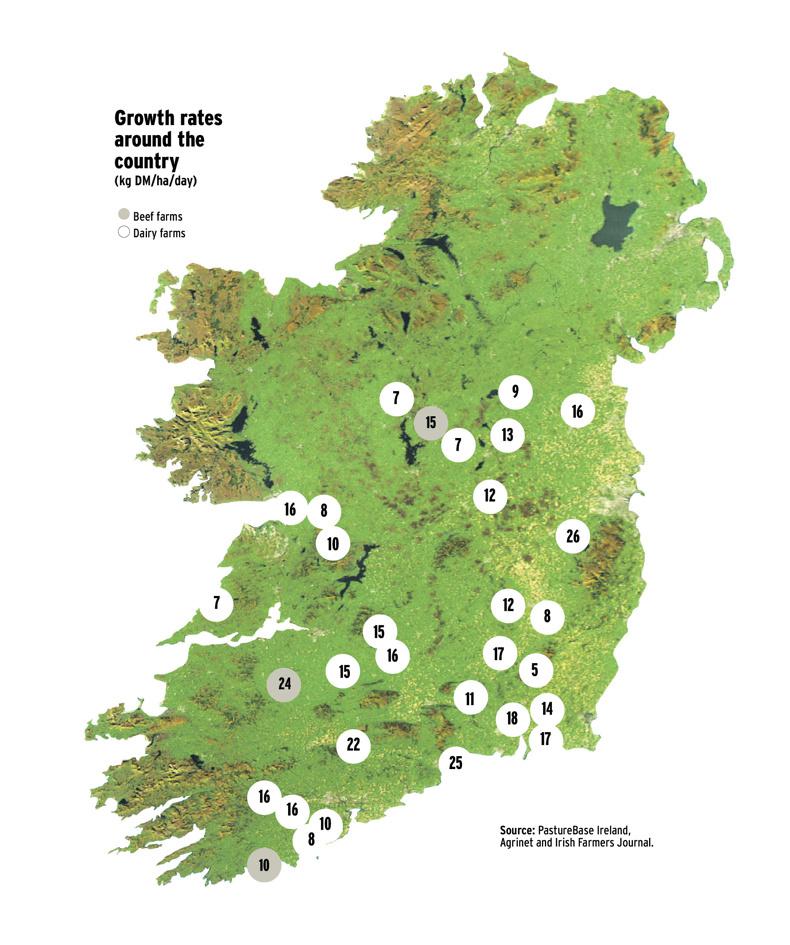

Co Louth
System suckler to bull beef
Soil type free-draining
Avg farm cover (kg DM/ha) -
Grass demand (kg DM/ha/day) -
Growth (kg DM/ha/day) -
The majority of stock is housed at this stage with the exception of some weanlings which are cleaning off the last few paddocks.
All bulls and some of the heifers will be housed this weekend and the remaining heifers will move to a catch crop which I have sown for winter grazing. Currently, I am in the middle of AI with my autumn-calving herd and thankfully it is going well so far. Those autumn-calving cows are currently on 72DMD silage ad-lib and 1.5kg of ration to keep them in shape for breeding. Spring-calving cows are currently being restricted on silage and straw to keep them fit for calving. Pre-calving minerals will be introduced to them in the next few weeks.
Last year’s autumn-born bulls are on ad-lib meal and I will start slaughtering them in December. The last of my spring-born 2016 heifers will be slaughtered next week at 20 months of age. All autumn-born calves will receive their booster shot for pneumonia this week.

Co Offaly
System organic suckler to beef
Soil type heavy clay
Avg farm cover (kg DM/ha) -
Grass demand (kg DM/ha/day) -
Growth (kg DM/ha/day) -
Despite the recent inclement weather, grazing conditions are holding up, with all of last year’s autumn-born calves still outdoors. The bullocks are grazing a field of turnip, rape and kale, while the heifers are currently on the stubbles from the oats also having access to the last of my grass. I weighed both groups of stock almost a month ago so it’ll be interesting to see the thrive, particularly from the bullocks on the winter crop. Both groups of stock will be housed next month.
Breeding is in full swing here and will continue for another four weeks. I’ve gone almost 100% AI here this year. Lisnacrann Fifty Cent (SI2469) is a bull I’ve used a lot this season. I’m focusing on getting more replacements on the ground while keeping size in my cows and he’s throwing some great calves. Surprisingly, my silage results are quite modest and I’m a bit disappointed with the red clover silage. I’ve plenty of fodder and the combi crop of peas and barley will reduce my concentrate bill.

Tullamore Farm
System suckler/calf to beef
Soil type variable
Avg farm cover (kg DM/ha) 629
Grass demand (kg DM/ha/day) 3
Growth (kg DM/ha/day) 17
We started our final rotation in early October grazing 1.83ha/day, which decreased to 1.44ha in early November. We hoped to have 100% of the farm grazed this week but it will be another week or so before we’re done given that growth has been slightly stronger than expected and recent rain has made for less than favourable grazing conditions. So the ewes will graze what’s left. Fifty cows started grazing kale on 27 October and 60 dairy heifers went to kale on 21 November.
The bulls are housed and are on a diet of 78% DMD silage, with 4kg of a 15% protein ration. Cows that scanned as not being in-calf are being fattened on a diet of 78% DMD silage ad-lib and 5kg of ration, with the weanling heifers getting 2kg/concentrates as well as 78% DMD fed ad-lib. Cows are being fed a maintenance diet of 62% silage ad-lib and are due to be body-condition-scored next week.
Dairy calves received boluses, were weighed and had their tails clipped before going on to kale.

Co Kerry
System suckler to weanling
Soil type variable
Avg farm cover (kg DM/ha) -
Grass demand (kg DM/ha/day) -
Growth (kg DM/ha/day) -
With the recent poor grazing conditions, all stock has been housed except for 26 calves who continue to be out by day eating approximately 1kg of ration, on ground which is too wet for the rest of the stock but would rot if left until spring. Eleven in-calf heifers are out full-time on rough grazing. Apart from them, all suckler cows, bull and heifer calves, cull cows and fat heifers have been housed since mid to late October, with younger stock eating a diet of high-quality paddock silage of 71-72 DMD and 1kg of ration while the suckler cows are eating lower-quality silage.
We removed cubicles from a slatted house to create more lying space, on which we may insert rubber mats in the near future. We also put on a small extension on an old slatted shed by putting in a dry bed area alongside it.
Two months ago, we scanned 58 females, of which 51 were in-calf. We culled the empties and bought in an extra six high-index cows.
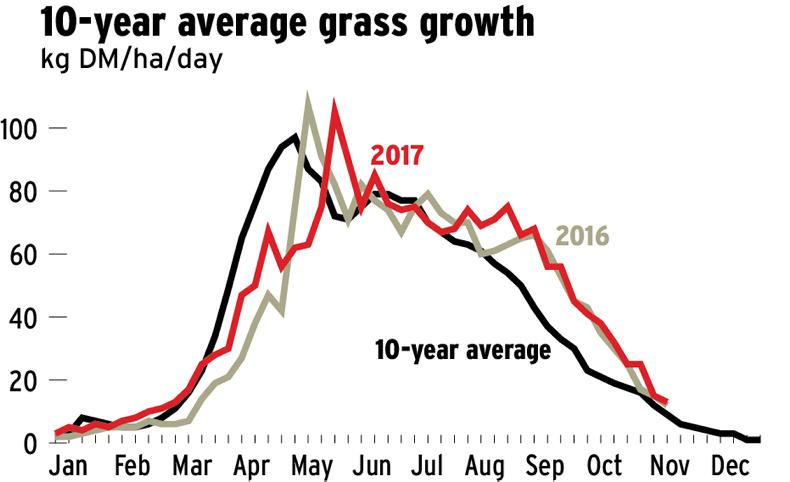
Read more
Grass+ dairy: good grass year coming to an end
A damp weekend brought the last beef stock in across the country. Mild weather since has led to a lot of pneumonia in sheds. Doors of cattle houses should be left open. If there is wind blowing on to the pen they’re in, but cattle can move to a point where there are no draughts as they please, then this is fine.
As farmers push to make good-quality silage, digestibility increases. The transition from grass to this type of material can be stressful for a young animal as their stomach adjusts. This can be one element of a perfect storm for respiratory disease.
The rapid passage rate of high digestibility and/or low dry matter material through the animal can reduce the amount of nutrients absorbed – not unlike one of the main mechanisms that can lead to grass tetany in suckler cows on wet grass.
Pneumonia
Couple this with a warm shed, a bulling animal in a pen, new pen mates fighting to establish a hierarchy or a management disturbance like clipping or dosing and it’s easy to see how the planets can align for pneumonia.
Vaccinations will help but a vet once described these to me as an extra weight on the prevention scales. If we put enough undesirable weight on the other side – ie stressors/disease burden – then even a vaccination won’t save us.
Remember that many of the main disease-causing agents are in or around the animal’s system or environment already. A weakening of the immune system (stressor) is what lets them in. Animals off feed is the big warning light for me. Any animal not coming in to eat should have their temperature taken immediately and a vet called at or above 39.5°C. Don’t try to be a hero and take it in the pen – you will get kicked or worse. Use handling facilities.
Snotty cattle
We are getting a lot of queries about snotty cattle and coughs. Snots are a sign that the animal’s immune system is working against something; if the animal is eating and it is an isolated example, then I wouldn’t worry. A cough post-feeding can be a result of the dryness of a concentrate feed, but lots of coughs in a shed before feeding should be investigated.


Co Louth
System suckler to bull beef
Soil type free-draining
Avg farm cover (kg DM/ha) -
Grass demand (kg DM/ha/day) -
Growth (kg DM/ha/day) -
The majority of stock is housed at this stage with the exception of some weanlings which are cleaning off the last few paddocks.
All bulls and some of the heifers will be housed this weekend and the remaining heifers will move to a catch crop which I have sown for winter grazing. Currently, I am in the middle of AI with my autumn-calving herd and thankfully it is going well so far. Those autumn-calving cows are currently on 72DMD silage ad-lib and 1.5kg of ration to keep them in shape for breeding. Spring-calving cows are currently being restricted on silage and straw to keep them fit for calving. Pre-calving minerals will be introduced to them in the next few weeks.
Last year’s autumn-born bulls are on ad-lib meal and I will start slaughtering them in December. The last of my spring-born 2016 heifers will be slaughtered next week at 20 months of age. All autumn-born calves will receive their booster shot for pneumonia this week.

Co Offaly
System organic suckler to beef
Soil type heavy clay
Avg farm cover (kg DM/ha) -
Grass demand (kg DM/ha/day) -
Growth (kg DM/ha/day) -
Despite the recent inclement weather, grazing conditions are holding up, with all of last year’s autumn-born calves still outdoors. The bullocks are grazing a field of turnip, rape and kale, while the heifers are currently on the stubbles from the oats also having access to the last of my grass. I weighed both groups of stock almost a month ago so it’ll be interesting to see the thrive, particularly from the bullocks on the winter crop. Both groups of stock will be housed next month.
Breeding is in full swing here and will continue for another four weeks. I’ve gone almost 100% AI here this year. Lisnacrann Fifty Cent (SI2469) is a bull I’ve used a lot this season. I’m focusing on getting more replacements on the ground while keeping size in my cows and he’s throwing some great calves. Surprisingly, my silage results are quite modest and I’m a bit disappointed with the red clover silage. I’ve plenty of fodder and the combi crop of peas and barley will reduce my concentrate bill.

Tullamore Farm
System suckler/calf to beef
Soil type variable
Avg farm cover (kg DM/ha) 629
Grass demand (kg DM/ha/day) 3
Growth (kg DM/ha/day) 17
We started our final rotation in early October grazing 1.83ha/day, which decreased to 1.44ha in early November. We hoped to have 100% of the farm grazed this week but it will be another week or so before we’re done given that growth has been slightly stronger than expected and recent rain has made for less than favourable grazing conditions. So the ewes will graze what’s left. Fifty cows started grazing kale on 27 October and 60 dairy heifers went to kale on 21 November.
The bulls are housed and are on a diet of 78% DMD silage, with 4kg of a 15% protein ration. Cows that scanned as not being in-calf are being fattened on a diet of 78% DMD silage ad-lib and 5kg of ration, with the weanling heifers getting 2kg/concentrates as well as 78% DMD fed ad-lib. Cows are being fed a maintenance diet of 62% silage ad-lib and are due to be body-condition-scored next week.
Dairy calves received boluses, were weighed and had their tails clipped before going on to kale.

Co Kerry
System suckler to weanling
Soil type variable
Avg farm cover (kg DM/ha) -
Grass demand (kg DM/ha/day) -
Growth (kg DM/ha/day) -
With the recent poor grazing conditions, all stock has been housed except for 26 calves who continue to be out by day eating approximately 1kg of ration, on ground which is too wet for the rest of the stock but would rot if left until spring. Eleven in-calf heifers are out full-time on rough grazing. Apart from them, all suckler cows, bull and heifer calves, cull cows and fat heifers have been housed since mid to late October, with younger stock eating a diet of high-quality paddock silage of 71-72 DMD and 1kg of ration while the suckler cows are eating lower-quality silage.
We removed cubicles from a slatted house to create more lying space, on which we may insert rubber mats in the near future. We also put on a small extension on an old slatted shed by putting in a dry bed area alongside it.
Two months ago, we scanned 58 females, of which 51 were in-calf. We culled the empties and bought in an extra six high-index cows.

Read more
Grass+ dairy: good grass year coming to an end
















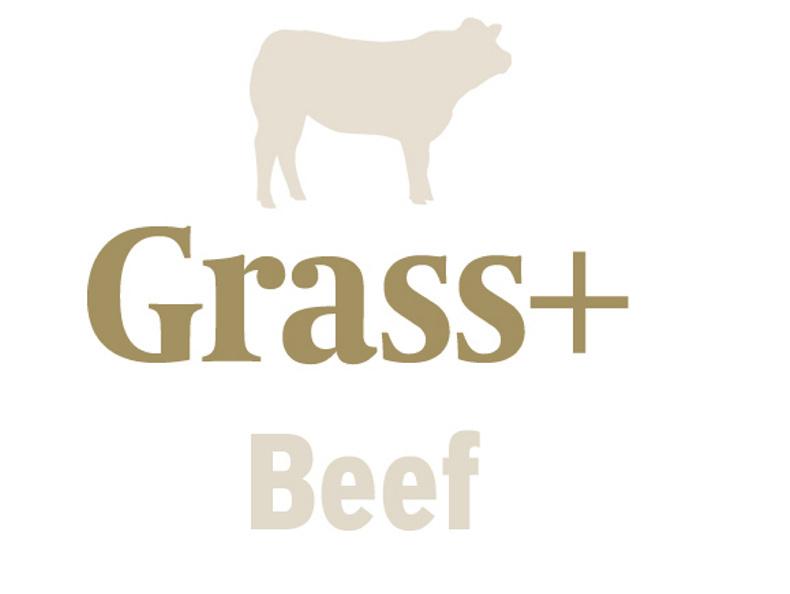

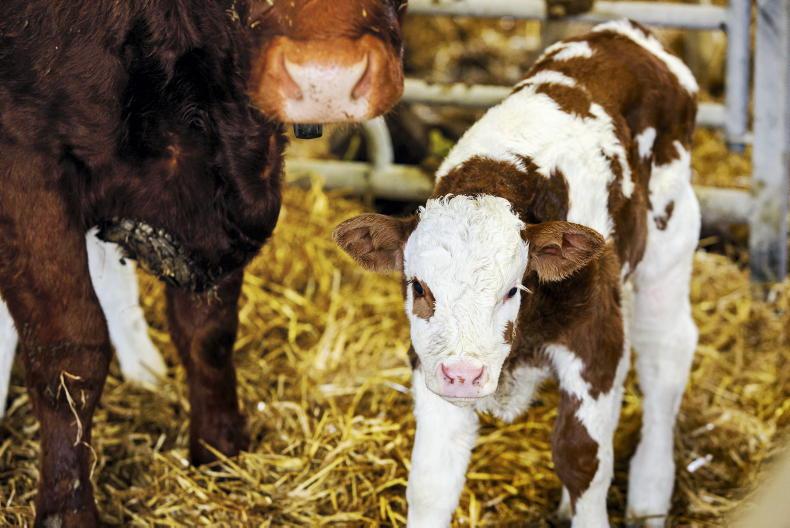
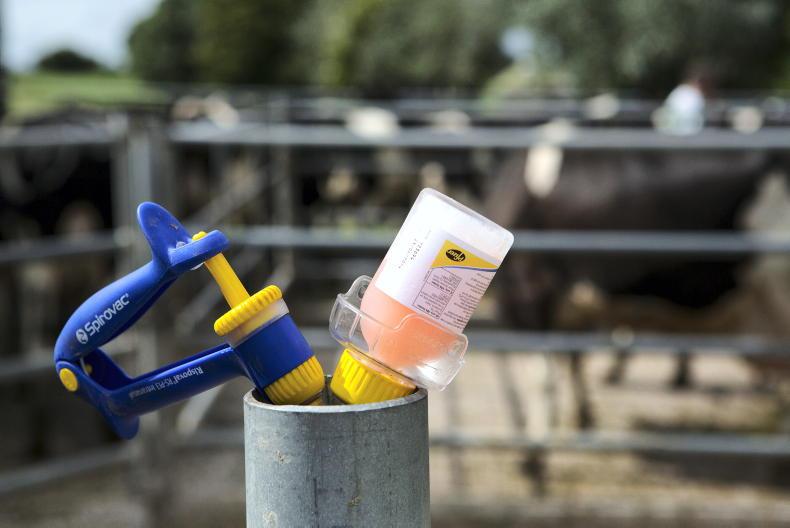
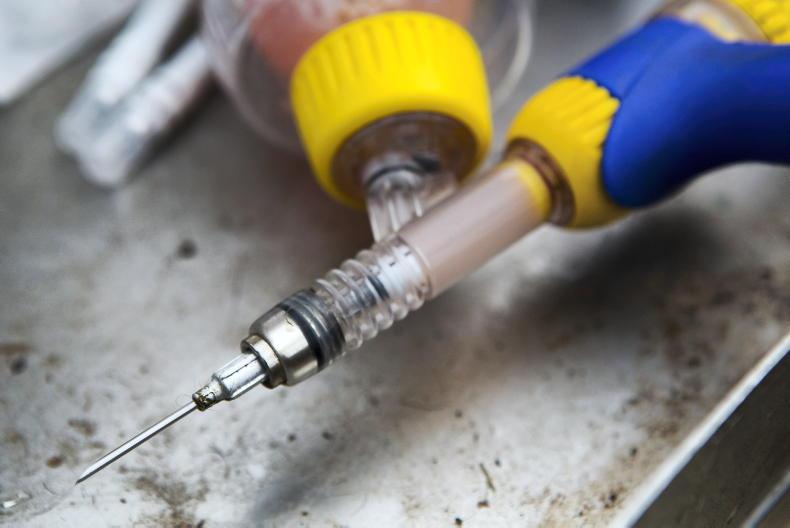
SHARING OPTIONS